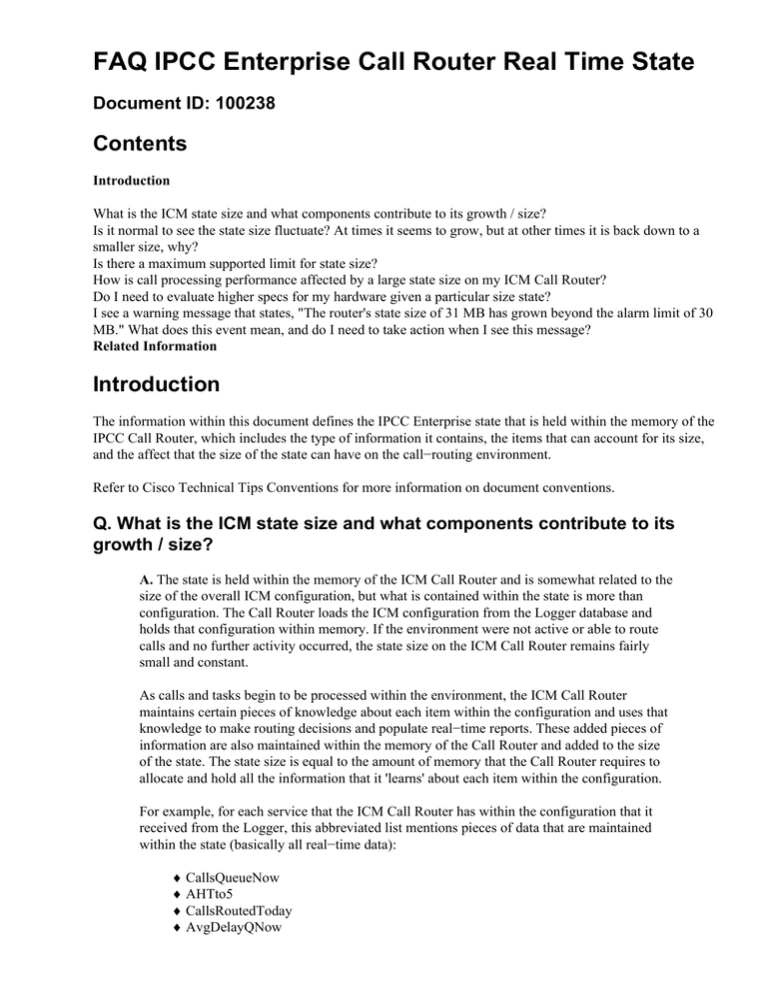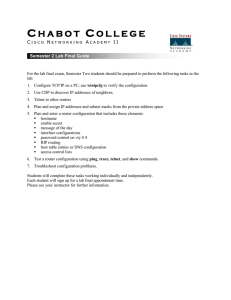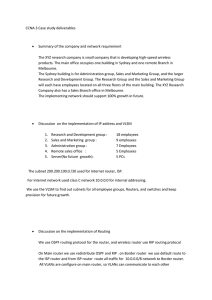
FAQ IPCC Enterprise Call Router Real Time State
Document ID: 100238
Contents
Introduction
What is the ICM state size and what components contribute to its growth / size?
Is it normal to see the state size fluctuate? At times it seems to grow, but at other times it is back down to a
smaller size, why?
Is there a maximum supported limit for state size?
How is call processing performance affected by a large state size on my ICM Call Router?
Do I need to evaluate higher specs for my hardware given a particular size state?
I see a warning message that states, "The router's state size of 31 MB has grown beyond the alarm limit of 30
MB." What does this event mean, and do I need to take action when I see this message?
Related Information
Introduction
The information within this document defines the IPCC Enterprise state that is held within the memory of the
IPCC Call Router, which includes the type of information it contains, the items that can account for its size,
and the affect that the size of the state can have on the call−routing environment.
Refer to Cisco Technical Tips Conventions for more information on document conventions.
Q. What is the ICM state size and what components contribute to its
growth / size?
A. The state is held within the memory of the ICM Call Router and is somewhat related to the
size of the overall ICM configuration, but what is contained within the state is more than
configuration. The Call Router loads the ICM configuration from the Logger database and
holds that configuration within memory. If the environment were not active or able to route
calls and no further activity occurred, the state size on the ICM Call Router remains fairly
small and constant.
As calls and tasks begin to be processed within the environment, the ICM Call Router
maintains certain pieces of knowledge about each item within the configuration and uses that
knowledge to make routing decisions and populate real−time reports. These added pieces of
information are also maintained within the memory of the Call Router and added to the size
of the state. The state size is equal to the amount of memory that the Call Router requires to
allocate and hold all the information that it 'learns' about each item within the configuration.
For example, for each service that the ICM Call Router has within the configuration that it
received from the Logger, this abbreviated list mentions pieces of data that are maintained
within the state (basically all real−time data):
♦ CallsQueueNow
♦ AHTto5
♦ CallsRoutedToday
♦ AvgDelayQNow
♦ AgentsTalking
♦ ASAto5
When you consider state size, you also need to take into consideration that this is true for
every object within the configuration: Skill Groups, Services, Trunk Groups, Scripts, Agents,
LAA or MED values, etc. All these items held within the configuration also have real−time
data that the router learns and holds within its memory. The state is updated constantly based
on information that comes into the router from PGs and NICs. Most of this real−time data is
passed out through the real−time feed, populated in the real−time tables on the administrative
workstations, and used for real−time reporting. The more items in the configuration, and the
more real−time data there is about them, the bigger the state size grows.
Q. Is it normal to see the state size fluctuate? At times it seems to grow,
but at other times it is back down to a smaller size, why?
A. Yes, this is normal behavior to see the state size grow as the memory allocated to the state
as required by the amount of real−time detail grows. The amount of data that the ICM Call
Router receives at the configuration from the Logger database is only one part of what makes
up the full state size. Many other factors add to the size of the state because many other pieces
of information are held within the memory of the Call Router in order to complete the tasks
associated with intelligent call routing and real−time reporting. As activity within the
environment changes and tasks are processed, so does the state size change.
For example, when the initial load of configuration and state is sent to the Call Router,
information about configured agents is included. Information about those agents is updated by
each peripheral as to which skills the agents are logged into. This data is held in the real−time
data for SkillGroupMembers. If those agents are then reskilled to another skill group, the
original data for that agent skill assignment still exists within the state of the Call Router, and
the new skill assignment is also added. The information for the original skill assignment of
the agent is kept within the Call Routers state in order to complete real−time reporting for that
agent. Since information about the skill assignments of this agent is now increased, the
memory required for the Call Router to hold that data is also increased, and the state size
grows larger.
Note: This is only one example of how the state can require the memory allocation for
real−time state data to also increase; other types of data can also cause the state to grow in
this manner.
Q. Is there a maximum supported limit for state size?
A. State size is affected by configuration size and changes, as well as call volume and
activity, such as agent reskilling. Because of this fact, it is impossible to predict the size of the
state based on the size of the configuration within the Logger database, and it can grow larger
in some environments more so than others. Cisco does not dictate any specific limits to the
upper bounds of the state size for any one customer environment, but at 1500MB a customer
is faced with these considerations:
♦ The 32−bit Microsoft Windows machines limit the memory per−process to 2000MB.
If the state size exceeds 1500MB, it can exceed the Microsoft Windows limit.
♦ Longer time is taken to complete state transfer across the private network.
♦ Increased memory usage and CPU utilization on the call routers and administrative
workstations: there must be enough physical memory to support the state size. On
modern hardware, with 2−4GB of memory, this is seldom an issue.
♦ There is the necessity to provide more bandwidth and speed over the private network
to facilitate the state transfer, as well as over the public network to facilitate data
transfer to and from peripheral gateways and administrative workstations (*see note
below).
♦ Increased buffer utilization is needed for processes, such as the RTServer,
RTDistributor, and RTClient on the Administrative Workstations.
♦ Increased buffer utilization for is needed for processes, such as PGAG and CCAG
between the peripheral gateways and Call Routers.
♦ Increased size of the AWDB database can be necessary to accommodate an increased
amount of real−time data.
*The private network between sides must be able to transfer the state in a reasonable amount
of time. A brief outage can be expected within a state transfer as the state is prepared to be
sent. This is typically several seconds on a large state size. Within this window, calls can be
default routed.
Q. How is call processing performance affected by a large state size on
my ICM Call Router?
A. State size does not generally affect router performance in terms of call−per−second or
response time in handling a call. The only performance that affects a scenario, given a large
state size, is related to the network speed and resources required to perform a state transfer or
to pass the real−time information back down to devices within the environment (peripheral
gateways and administrative workstations) or in situations where the memory required by the
process exceeds the Microsoft Windows 32−bit limit of 2000MB.
The ability of the ICM Call Router to respond to inbound route requests and provide labels /
intelligent routing decisions is not affected by state size. Currently most IPCC Enterprise
customers operate successfully with state sizes in the 300−500MB range.
Q. Do I need to evaluate higher specs for my hardware given a particular
size state?
A. Recommendations for server sizing and capacity are outlined within the Hardware and
System Software Specification for Cisco Unified ICM / Unified CC Enterprise & Hosted
Editions, formerly know as The ICM Bill of Materials. Within this guide are the sizing
requirements for low and high−end deployments. As long as the state size is well below the
Microsoft Windows 32−bit limitation, there is no need to increase capacity or specifications
for hardware above those outlined within this document.
Q. I see a warning message that states, "The router's state size of 31 MB
has grown beyond the alarm limit of 30 MB." What does this event mean,
and do I need to take action when I see this message?
A. This message is informational. The number that is reported comes directly from this
registry value and does not affect performance.
Registry Value Location = /Router/CurrentVersion/StateTransfer/StateSizeThresholdMB.
Refer to the What Does the ICM Event "The router state size of 31 MB has grown beyond the
alarm limit of 30 MB" Mean? tech tip for further explanation of this value.
Related Information
• Technical Support & Documentation − Cisco Systems
Contacts & Feedback | Help | Site Map
© 2012 − 2013 Cisco Systems, Inc. All rights reserved. Terms & Conditions | Privacy Statement | Cookie Policy | Trademarks of
Cisco Systems, Inc.
Updated: Dec 13, 2007
Document ID: 100238








